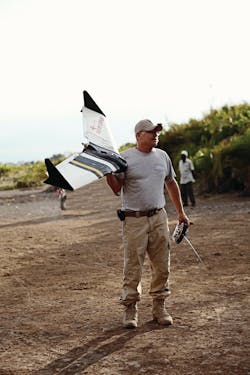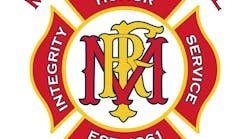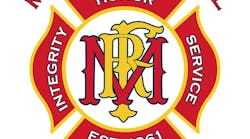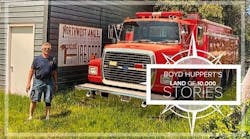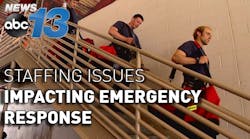University researchers are providing a futuristic view of what is on the horizon for fire departments nationwide – the ability to manage incidents with the use of unmanned aerial vehicles (UAVs). The concept was introduced in “Universities Aid Soaring Technology for Unmanned Aerial Vehicles” in the February issue; this article further describes university-based UAV research and efforts toward integrating the technology into fire service operations.
Among the institutions participating in the development of UAVs is San Diego State University (SDSU) in California. Dr. Eric G. Frost, an associate professor in the Department of Geological Sciences, directs SDSU’s Visualization (Viz) Center and co-directs the Homeland Security Master’s Program as well as the Center for Information Technology and Infrastructure. Frost and co-workers focus their educational and research efforts on disaster response worldwide and seeks ways to help governments, organizations and responders save lives and reduce property damage. His view of the role of UAVs is forthright: “They have an enormous and interesting potential for firefighting.”
Hindered by cumbersome Federal Aviation Administration (FAA) regulations, Frost is a proponent for the relaxed use of UAVs for all first responders. “What could be done with UAVs far outweigh the disadvantages, but the FAA prohibitions remain in place,” he says. Currently, without a specific permit, or Certificate Of Authorization (COA), UAVs are limited to line-of-sight operation of less than 300 feet of altitude, without the use of a GPS-driven flight path.
“This is really the only piece that we can’t do, which prevents us from using UAVs as a system. We can use certain component parts, but we’re prevented from integrating all of these because the one piece we have now that is not functional is the FAA rules. It’ sort of like having a tire when trying to define a car– A tire doesn’t mean that you have a car.”
A lot of the FAA concern, Frost says, “is how the UAV is interacting with other fire aircraft. What we need are accepted rules and practices to enable UAVs to be used on the fireground. The UAV becomes another tool in an incident commander’s toolkit. It provides a low-risk way of gathering information on the incident – such as a manned helicopter in high winds.
Real-world operations
Gene Robinson, a principal at RP Flight Systems in Wimberley, TX, near Austin, has developed the Spectra line of flying wing UAVs and deploys to natural disasters with aircraft, primarily for search and recovery.
“We have been to 29 states and four countries so far,” Robinson said. “We have concentrated quite a bit on search and rescue, search and recovery. Our aircraft are credited with 10 recoveries so far. We have flown fires, we have flown disasters. We flew in Hurricane Alexander as it came ashore on the Gulf Coast and we were flying in a measured 50-mile-per-hour wind.”
Robinson added, “We have the Spectra flying wing, which is a tier 1 unmanned aircraft. It weighs 4.4 pounds and it will stream live video or do high resolution stills and has FLIR (forward-looking infrared) capability as well. This allows us to see through smoke, which works very well in a fire situation. Aircraft are fairly small with 56-inch wingspan; and, they are very mobile. Incident command can watch video almost immediately once the aircraft is airborne. Our typical altitude is between 400 and 600 feet with the flight time of up to an hour. With two UASs airborne you can keep vision going continuously.
“At the moment you need a COA (for most advanced flight system operation). You have to apply to the FAA, and the only entities that can apply for a COA are government entities. The FAA is supposed to turn around a COA in 60 days, but it usually takes six months.”
Robinson said one work-around for a COA during a major incident is the inherent powers of the incident command structure.
“If you think about a major incident, usually a TFR is issued – or Temporary Flight Restrictions,” he said. “The person issuing a TFR essentially becomes the air boss of that area. They get to decide who and what flies. This relieves the FAA of any responsibility of flying a UAS (Unmanned Aerial System). So you can do this within the scope of the TFR,” he says
“It seems that everybody wants to get their hands on an unmanned aircraft – doesn’t matter if it’s fire police or other first responders. Unfortunately the FAA has pulled back on its original goal of trying to get a special regulation for UAS operation by last year. The privacy issue, which has been a very big issue in the press, is also a sticking point. But I would like to go on the record saying that I have terabytes and terabytes of video, and I do not have one naked lady…. It’s a bit ludicrous when you get down to it,” but that’s the public’s perception, he says.
“There are two main types of aircraft that agencies are looking at – the multi-rotor helicopters and fixed wing aircraft, like the Spectra. Many seem to think that the quad copter is the way to go because of its vertical takeoff and ability to use in an urban setting. But the urban area is the area that the FAA wants to keep us out of to mitigate risk.
“Mexico has been very receptive to us operating there, and we and SDSU have been able to utilize this opportunity. Other countries without the same restrictions that the FAA imposes are developing UAS platforms at a more rapid pace,” he says. Australia, Thailand, Vietnam are all vigorously developing unmanned aircraft and related technologies, he says. “They are very encouraged with the techno dollars that will come to their country. They are making it very attractive for developers to work there. I think that you’ll see unmanned aircraft do some pretty amazing stuff between now and 2015 – the date that the FAA is targeting for widespread use of unmanned aircraft,” Robinson says.
The student element at universities and colleges participating in UAV design and development is far reaching. Dr. Kelly Cohen, principal investigator for the University of Cincinnati’s SIERRA (Surveillance for Intelligent Emergency Response Robotic Aircraft) project, featured in the February article, said, “From the student perspective, they can reach out and engage problems that society faces. It makes them realize they need to be aware as good citizens what contributions they can make for society. It also allows them to be entrepreneurs. Educationally speaking, for my students, it has been very rewarding.”
